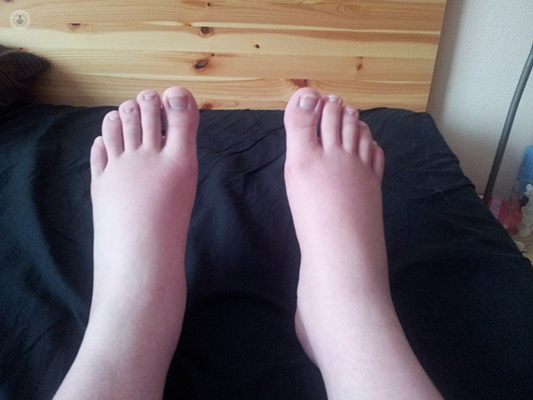



What is oedema?
Oedema (spelt “edema” in some countries) is swelling caused by the accumulation of fluid in a part of the body. It is often accompanied by inflammation. Oedema usually affects the feet, ankles and legs, although it can occur anywhere in the body. Pulmonary oedema, for example, occurs in the lungs and can cause difficulty breathing.
Symptoms of oedema
The main symptoms of oedema are:
- Stretched and shiny looking skin
- Swelling
- Feeling of heaviness or even pain
Causes of oedema
Oedema is caused by excess fluid becoming trapped in the body’s tissues, and this is often caused by fluid leaking from the bloodstream. Therefore, many of the causes of oedema have to do with things that affect the patient’s circulation. Factors that can lead to oedema include:
- Eating a lot of salt
- Being overweight
- Sitting or standing for a long time in the same position
- Pregnancy
- Certain medications
- Injury
- Liver problems
- Kidney problems
- Heart problems
- Problems with the lymph nodes
- Insect bites/stings
- Infections
- A blood clot
Can oedema be prevented?
There is no way to detect oedema before its appearance and thus avoid or prevent it. The risk of oedema can be lowered by maintaining a healthy body weight, not eating too much salt, and avoiding sitting in the same position for too long at any one time. These measures help maintain good blood circulation and minimise the chances of other health problems.
Oedema treatment
The best way to treat oedema is by directly treating the cause. It is very important to treat oedema because, in addition to the annoying symptoms, the skin can continue to stretch.
For swelling in the feet and ankles, the following can help:
- Lie down and raise the affected area with a pillow.
- Don’t wear tight clothes – especially shoes and socks. Wide, comfortable shoes with a soft sole and low heel are ideal.
- Do some gentle exercise – this will help improve circulation.
- Avoid sitting or standing in the same position for long periods.
- Keep your feet and ankles clean by washing, drying and moisturising them – this will help to avoid infections.
If oedema doesn’t improve on its own within a few days, you should consult a doctor, particularly if it gets worse. In the following circumstances, you should ask for an urgent appointment:
- You have a high fever and/or are shivering.
- The swelling is red and inflamed and feels hot to the touch.
- You also have diabetes.
- The swelling is particularly severe or painful.
- The swelling appears very suddenly.
- Only one foot or ankle is swollen and you have no idea why.
If you are short of breath, struggling to breathe, and/or are experiencing chest pain or tightness, call 999, as it could indicate a blood clot in the lungs.
Persistent oedema may require lifestyle changes, such as adopting a low salt diet or losing weight.